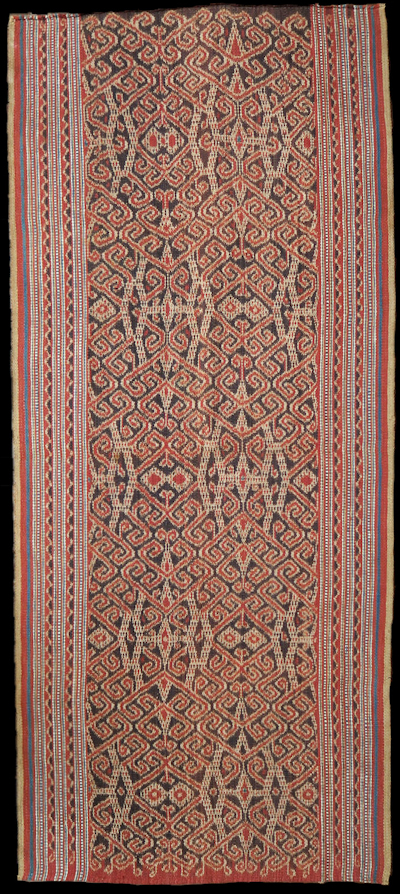| |
 
 | | | |
304 Borneo, Sarawak
Kain kebat (skirt cloth)
| | Locale: | Bale river area, most likely | | Period: | 1920-1940 | | Yarn: | Cotton, hand-spun, medium | | Technique: | Warp ikat | | Panels: | 1 | | Size: | 45 x 103 cm (1' 5" x 3' 4") LW: 2.29 | | Design: | This piece was selected for collection on account of its subtle, well balanced design, constructed by a triple repeat of the basic ikated motif. The design is called buah aji, shrew motif. Iban motifs are often related to the plait-work patterns of baskets and mats. This skirt appears to be a particularly illustrative example, as the weaver has avoided large patterns, seeking expression more in rhythm than in boldness, achieving an arresting pattern that plays games with the mind. Because the underlying patterns in red are not disturbed by the overlaying patterns in stippled white, the latter appear to lie on another plane, or in another dimension. The flipping over of the middle of the three BIMs introduces an element of tension into the almost fragile, restrained design. A skirt like this is best seen from a little distance; on-line by peering through the eyelids to make it shimmer. | | Comment: | Skirts contain some of the oldest known Iban patterns, handed on through the generations without significant changes. Skirts do not have the same ritual power and value as pua, and are made in an insouciant, restorative mode, in between the making of pua that put the weaver spiritually at risk. While generally sold for less than pua from the same region on account of their smaller size, skirts are often more intricate in design, take as long or longer to make, and contain some of the finest weaving of the Ibanic people. The smallest details were made by placing ties on skeins with only six threads (two for each panel). All natural dyes. Ex collection Yong Li Lan. | | Background: | Chapters on Borneo and Sarawak. | | Compare: | 212 220 229 242 300 | | Sources: | Very similar to kain kebat in Gavin, The Women's Warpath, Plate 55, though with a higher level of sophistication in the field, and less elaborate borders. Another similar sarong is worn by a Baleh weaver involved in a mordanting process on a photo in the same work, Fig. 25. Similar to undated Baleh kain kebat in Heppell, The Seductive Warp Thread, Fig. 108, not just in overall appearance, but particularly with regard to the construction of the borders with their parallel bands of short white blocks, respectively dots. Note that like the Heppell example it does not have the usual black bands along the selvedges. | | |

©Peter ten Hoopen, 2025
All rights reserved.
|
|


